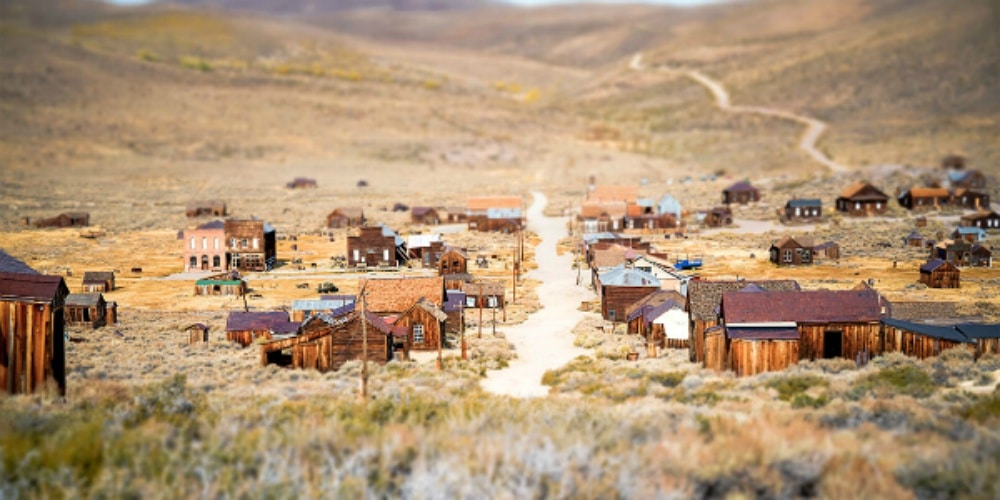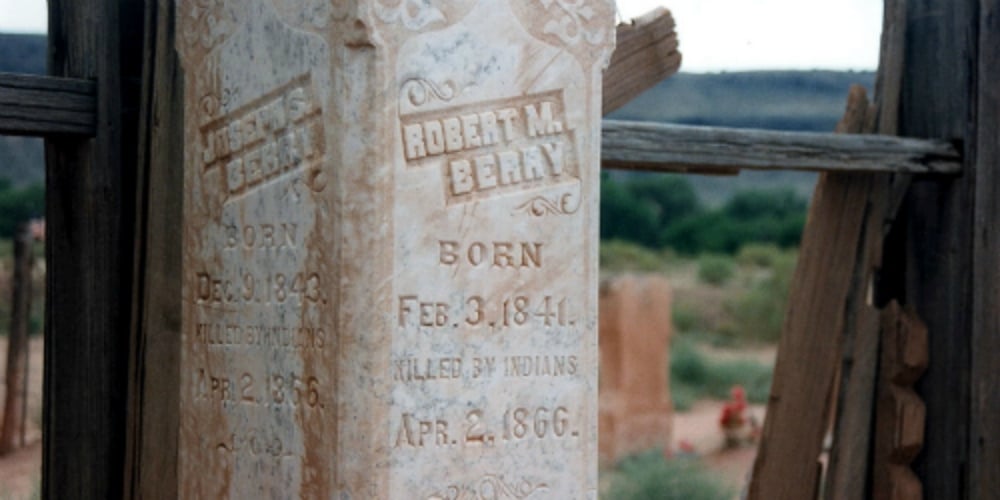Rolling tumbleweeds, dusty dirt roads, old saloons – this is the imagery that conjures up ghost towns of the American West. During the gold rush and silver rush that brought prospectors flooding into the West, small towns boomed and then fell after the veins of riches dried up. While many of these small and nearly-deserted towns are dotted all over the American West, there are some that are truly frozen in time, giving visitors an eerie glimpse into the distant past.

Bannack State Park, Montana
The town of Bannack, named for the local Native Americans, was founded in 1862 when gold was found in a nearby creek. The town was briefly the territorial capital of Montana until it was moved to Virginia City. In the 1950s the state of Montana took over the town and turned it into a historical park and preserved many of the buildings. Today Bannack has over sixty buildings that visitors can tour: a jail, church, several houses, a school, a cemetery and more. This park is an excellent and well-preserved example of what a real gold rush boom town looked like and how residents lived in that time. Want to take your Old West adventure up a notch? Stay overnight in the park and camp in a teepee. Onsite tent and RV camping is available for guests. There are limited campsites, so advance reservations are a must.
Admission: $6 per car, Montana residents are free.
Garnet, Montana
Garnet is a town that had more than one revival. Although not easily accessible (down an 11-mile dirt road), it is one of the best-preserved examples of a mining town on the frontier with many historic buildings to explore. It’s wise to visit early in the day to give your family plenty of time to sightsee. There are many hiking and mountain biking trails in and around the park, in addition to back-country camping. Kids will love fishing in Elk Creek and the Blackfoot River, which was made famous by the book, A River Runs Through It. For snowmobiling and cross-country skiing, consider visiting in the winter. There are cabins available for rent that come equipped with everything to keep you warm and toasty on a snowy winter night.
Admission: Adult (16 and older) $3, Children Free

Virginia City and Nevada City, Montana
Visitors to historic Virginia City can spend the day in a beautifully restored Old West mining town that was once the capital of the Montana Territory during the glory days of the gold rush. The area surrounding the town, known as Alder Gulch, is the site of the richest gold strike in the Rocky Mountains, estimated at 30 million dollars. Visitors can experience the Old West by staying in the town at one of the historic inns or cabins. Little miners will love the train ride that travels between Virginia City and Nevada City. Visitors can also pan for gold (and garnet), enjoy horseback riding or take a ride in a stagecoach. Between the two towns, there are over 248 historic buildings that can be toured, along with the Nevada City Museum that houses over a million preserved artifacts (the largest collection of Old West artifacts outside the Smithsonian). This museum hosts a living history event nearly every weekend, complete with reenactors.
Daypass (Unlimited train rides, Panning for gold and Entrance to the Nevada City Museum):
Adults $39 (for 2 people), Senior (55+) $35 (for 2 people) Family Day Pass $99 (good for 5 people for 2 days)
Bodie State Historic Park, California
This town is frozen in time and considered by many to be the best example of a ghost town. Another town built by the gold rush, Bodie was founded in 1859, then abandoned when the gold dried up. This town was taken over by the California Parks Department in 1962 when it became a state historic park. The 100 buildings that are left in this historic park are, unfortunately, not open to the public but can be viewed from the outside. This town leaves visitors with the feeling that it was abruptly abandoned overnight – with personal items and furniture left as if someone might return home. Although Bodie is open year-round, it is difficult to reach in the winter due to the heavy snow fall. This park is situated at a high elevation (8,375 feet) with thin air, making walking around the town tiring. Be sure to bring plenty of water and snacks to refuel and dress for cooler weather. Although the dirt road makes this a bit of a rough ride to get to, this town is worth the visit. If you plan to visit, be sure to bring exact change (cash only).
Admission: Adults $8, Youth (4-16 years old) $5, Children (3 and under) Free

Calico, California
Although this ghost town has been turned into something of a tourist attraction, it is the site of the biggest silver strike in California history. Tour a real silver mine, pan for gold, visit the Lucy Lane Museum and the Mystery Shack (like a fun house) or take a train ride. Visitors are welcome to camp or rent one of the on-site cabins or bunk houses. Spend a Saturday night on a ghost tour or venture on an off-road tour into the desert that takes visitors to harder to reach historical sites. Each attraction is an additional cost to the entrance fee, but package deals are available. For those who just prefer to leisurely wander through town, there are plenty of shops and dining options.
Admission: Adults $8, Youth (4-11) $5, Children (3 and Under) Free
Goldfield, Arizona
Along the same vein as Calico, this historic town has been turned into a tourist attraction. Many visitors come in search of the Lost Dutchman Mine, a legendary gold mine believed to be hidden in the Superstition Mountains. This Old West town has plenty to keep the whole family entertained: ziplining, horseback riding through the desert, a shooting gallery, a fun house, a historical museum, live reptile displays, mine tours, gold planning and a dramatic reenacted shoot-out. Each attraction has a separate entrance fee, and some require reservations in advance.
Tortilla Flats, Arizona
This Old West town is in Tonto National Forest on the Apache Trail in the Superstition Mountains. With a population of just six people, Tortilla Flats has rightfully earned the nickname, “The Town Too Tough to Die.” This is a great place to stop for lunch and stretch your legs if you happen to be following the Apache Trail. The Country Store serves a full menu of delicious foods – including a prickly pear gelato for the adventurous foodie. The saloon walls are decorated with money from all over the world, placed there by the town’s many visitors. There is a gift shop that sells Native American jewelry and pottery. Not to miss: Every Saturday and Sunday from December through Easter are live gunfight shows.
Grafton, Utah
There is nothing touristy about Grafton, Utah. In fact, it’s so authentic that the movie Butch Cassidy and the Sundance Kid was filmed here. The town was founded 1859 as a farming project by Brigham Young, rather than a gold rush town. The cemetery is one of the most interesting features of this ghost town, looking exactly as one might imagine a frontier cemetery might look, complete with a placard that lists the residents and their causes of death.

Lake Valley, New Mexico
Lake Valley is a small ghost town in what seems like the middle of nowhere. It is the remains of a silver rush town that was founded in 1878. The largest silver deposit in New Mexico – worth over two million dollars – was found at this mine. The town has been mostly restored, and the groundskeeper opens the schoolhouse for visitors to peek inside. Take note: This site is not open on Tuesdays or Wednesdays, and plan ahead with drinks, snacks and a full tank of gas if you make the trek.
Berlin, Nevada
Berlin is considered one of the best-preserved ghost towns in Nevada. This town was founded in 1863 when silver was discovered in nearby Union Canyon. Junior paleontologists will especially enjoy visiting this site, as this park contains the largest number of Ichthyosaur fossils in the world. Ichthyosaurs were marine dinosaurs that lived in the oceans 225 million years ago, when Nevada was under water. Some of these fossils can be viewed at the Fossil House, and visitors can also make reservations to tour the mine. (The minimum age to tour is six years old.) For the adventurous family, there are hiking trails and camp sites (both tent and RV).
Admission: $3.00
By Kimberly Crawford

